Once again, Google has pushed out a significant core quality update. From what we can see, these changes have strongly affected a large number of sites. Now that some time has passed, we have an idea of what types of sites were affected. At the end of this article, we will include our tips on what to do if you have seen losses.
What we know so far about the June 3 Core Algorithm update
The update was preannounced by Danny Sullivan on Twitter.
It went live on June 3.
As of June 8, it was fully rolled out.
Multiple updates may make analysis confusing
While we are thrilled that Google is now giving us more information about updates, we were quite surprised to see that they pushed out a second update, called the Diversity Update, at the same time as the June Core update was running.
From what we can see, most, if not all of the sites that have come to us requesting a site review, were not likely to be affected by the diversity update. It is our opinion, that if your traffic dropped during the first week of June, it is much more likely to be due to the core update rather than the diversity update. Also, it is worth mentioning that there are many other possible causes for traffic drops. If your traffic is down, the first items we would recommend checking are the following:
- Have you recently made changes to your website? Have urls changed? Internal linking? Changes to robots.txt? etc.
- Has one particular competitor started overtaking you? It may not be that you have dropped, but rather, they have seen improvements.
- Have rankings dropped on just Google? If you’re seeing drops in Bing and other search engines, then the changes are likely not due to changes in Google’s algorithms.
- Is it possible that the changes you are seeing are seasonal?
In most cases though, if you are looking at your Google organic traffic and notice a significant change in Google organic traffic patterns that started between June 3 and June 8, you were probably affected in some way by the June core update.
The June 4, 2019 Diversity Update
From what we can see, the diversity update did not have a massive effect on traffic for sites that were affected by it. We had initially wondered whether sites like Yelp would see drops given that Yelp would often hold multiple positions on the first page. According to SEMRush, Yelp actually saw increases in early June.

It should be noted that SEMRush did an update to their keyword database on June 4. This makes competitive analysis tricky! Wherever possible in this report, we have also included Ahrefs traffic data. Unfortunately Ahrefs does not have organic traffic data for Yelp.
Another site that we thought would see drops due to the diversity update is Open Table. Check out the historical SERPS for “restaurant near me” according to SEMRush. Take note though that it is hard to say whether this actual SERP would appear in real life as this is the type of query that would be greatly impacted by the location of the searcher.
According to SEMRush historical data, here is what the SERPs looked like in April of 2019.

And here is what they look like today.
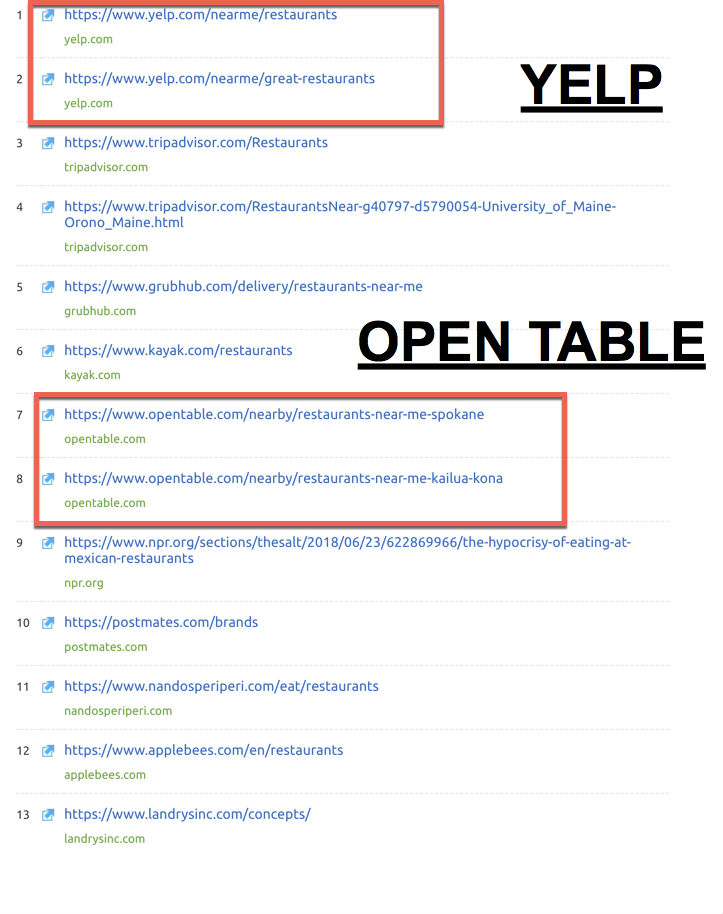
Again, this is not the perfect example, because very few people would search for “restaurant near me” without Google using some sort of location modifier.
What we found interesting though, is that we could not find a case of a site that we felt lost important rankings or traffic because of the diversity update. Here is Open Table’s traffic trend on SEMRush.

And also, on Ahrefs.
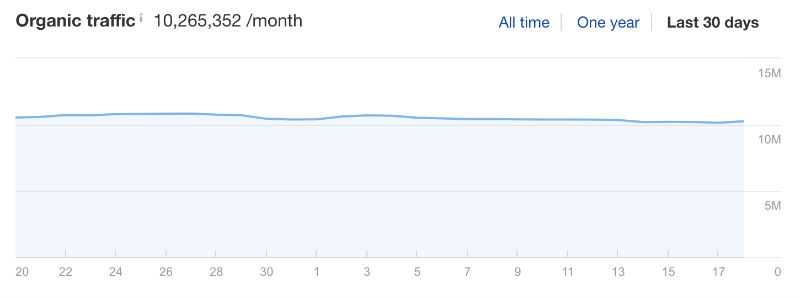
We were expecting to see much larger drops. In our minds, it stands to reason that if a site used to have 3+ listings on page one and dropped to 2 listings, they’d lose clicks. Sure, not many people click on results lower on the page, but surely some people did?
But, it seems that this is not the case. It is possible that if you lost some rankings in the diversity update, the rankings for the remaining two listings you do have, may be strengthened.
There is likely more to this diversity update. Dr. Pete from Moz has published a post with his thoughts and his conclusion is that “the impact of the diversity update doesn’t feel on par with a pre-announcement and the PR it received.”
For the rest of this article we will focus on what changes likely happened with the June Core update, rather than the diversity update, as the core update is likely the culprit for most changes seen by sites in the first week of June.
What types of sites were affected by the June 2019 Core algorithm update?
Normally when Google pushes out a big update, it is fairly clear to us what types of sites were affected. It is usually relatively easy for us to come up with theories on what changes Google made. This time, we were more challenged. We have several theories on what we think happened. But, please know that none of these are presented with absolute certainty.
Health Sites
A large number of health sites that we monitor saw significant changes. We admit though, it is possible that our data is skewed by the fact that we have a lot of clients who came to us for help after being negatively affected by the August 1 (Medic) Update. We felt the August 1 update was primarily a YMYL (Your Money or Your Life) update. While not all sites that were hit were medical in nature, many were.
We had some health clients make nice improvements with the June 3 core update. (Note: Screenshots below are from SEMRush and also Ahrefs. For sites that we have GA access to, we only post traffic graph screenshots when the trend lines up with what we are seeing in Google Analytics. We tend not to post GA data directly unless given specific permission from our clients to do so.)
This site is a health site that was negatively affected by the unnamed September 27 Google update. They are making nice gains with the June 3 update.

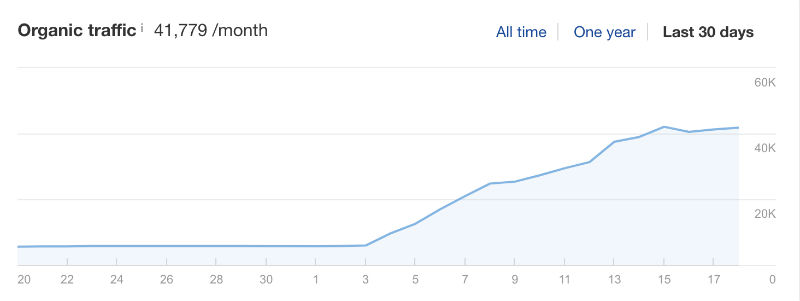
Here is another health site, with many natural medicine topics that was a client of ours as well.

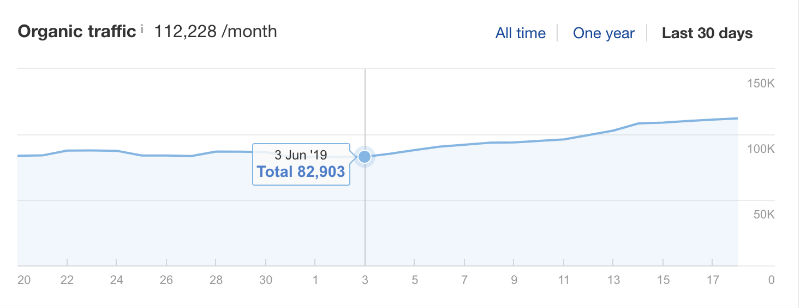
In all honesty though, several alternative medicine sites that were clients of ours saw drops in traffic with the June 3 update. Each of the following sites are relatively small sites who formerly ranked for many natural medicine queries:



One thing that each of these sites have in common is that they are covering subjects that possibly contradict general scientific consensus. The Quality Raters Guidelines (QRG) instruct the raters to assess the following. This is from section 3.2 of the guidelines on E-A-T.
![]()
Note: If you are not familiar with the QRG and their connection to Google’s algorithms, you can find more information here:
- A thorough description of E-A-T and SEO
- What can Google’s Updated QRG tell us about Quality in 2019?
We would imagine that it can be challenging for Google to recognize when medical content is accurate and when it is not. But we do not think it is impossible. This is a theory, but we believe Google could use Natural Language Processing to determine what people are saying online about medical companies and determine whether their content is deemed trustworthy. For example, take a look at a site we have discussed often, although they are not clients of ours. DrAxe.com is a good example of a site that has some elements of E-A-T, namely “E” and “A” but is potentially lacking in trust for several reasons.
We have spoken before about how this site likely saw drops with the August 1 update in connection with issues surrounding bad reputation. They appear to have seen improvements with the March 12 core update (most likely after making changes to their review profiles across the web), and then have been hit again with this June 3 update.
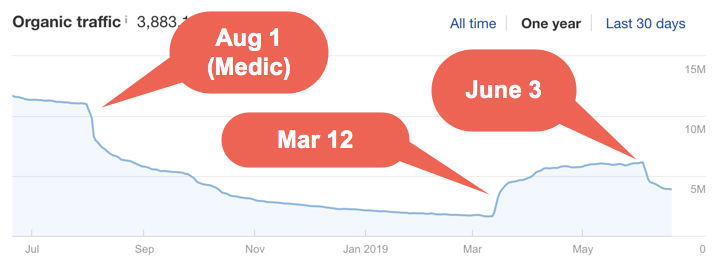
We think it is possible that this latest June 3 hit is due to Google wanting to put even less emphasis on sites that promote health treatments that are not recognized by traditional doctors as valid treatment options. Does this mean that Google is always right? Most likely no. We believe that there are many natural medicine sites that truly do great work and help people. But, we also believe that there are far more natural health websites that are potentially giving people dangerous or unproven advice.
At the end of this document, we’ll list out our thoughts on what you can do to work towards recovery if you run a natural medicine site that was affected negatively by this update.
eCommerce sites
We were thrilled to see that many of our eCommerce site review clients are seeing nice gains.



One unifying trend that we see amongst eCommerce sites that saw improvements was that they were all businesses who already had good brand recognition.
We mentioned in our post on what had changed in the QRG for 2019 that there was some interesting wording that could possibly suggest Google was going to “turn up the dial” on brand authority. The previous version of the QRG used to say this in one of their examples:
“The Marriott website gives information on Marriott hotels, a popular chain of hotels and the information on this page is highly authoritative.”
It now says this:
“The Marriott website gives information on Marriott hotels, a popular chain of hotels. Marriott has a good reputation and is an expert on Marriott hotels, making the information on this page highly authoritative.”
In other words, it is possible that Google is saying that information on the website of a well recognized authoritative brand should be treated with more trust simply because of their brand recognition.
We predicted that a future update would make it so that brand authority was a larger ranking signal. There is a good chance that this has happened with this update.
It certainly is possible that these sites saw improvements because of other quality related changes. The information at the end of this document, especially the parts on brand authority will help get you on the right track for improving E-A-T for eCommerce stores.
Cryptocurrency sites?
This is a tough one to assess. Part of the reason why it took us so long to come out with this article is because we were thoroughly assessing the situation with CCN.com. CCN is a relatively well known cryptocurrency site that saw significant drops with the June 3 update. Both SEMRush and Ahrefs are reporting big drops.

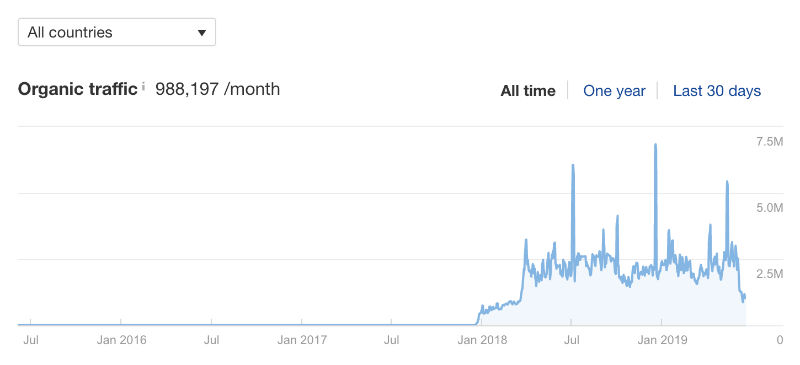
You’ll notice though, that this site only started getting traffic in early 2018. This whole situation with this site is complicated. We had initially thought that there were obvious trust issues. Staff members on the MHC team who are active in cryptocurrency trading pointed out that this site tends to have more “fluff” type articles and less actual meat than some of the more widely recognizable sites. As such, our initial impression was that Google had assessed some or much of the content on this site as untrustworthy.
After digging in for what was likely far too long for a non-client review, (as SEO’s will understand what happens when you end up chasing rabbits down holes), we realized that there is far more going on with the CCN situation than meets the eye. While their drops may be due to the changes Google made, it is also possible that the drops were not because of this algorithm update. Or, if they are, they could be due to Google reassessing several signals including brand authority and link trust.
There are odd issues with redirects from an older version of the site to the new version. There is also a lot of discussion on this potentially being a PR stunt as the site declared within a couple of days after being hit that they were now being forced to shut the entire shop down. They did certainly get a large number of links, including one from us. 🙂
We searched through the last couple of weeks of posts on the Google Webmaster Help forums to see whether we could find evidence of other cryptocurrency sites being hit. There was one other post about a small ethereum site that saw drops, but this site clearly was lacking in authority and had very obvious E-A-T issues.
We do not believe that this update specifically targeted crypto sites. We believe that if CCN’s drops are related to this update, it could be due to Google turning up the dial on brand authority. Sites like cointelegraph.com and coinbase.com saw massive gains with this update. Again, our staff who are active in the world of cryptocurrency felt that these two sites were much more recognizable than ccn.com.
It is also possible that Google has made changes to how they value keyword anchors in links and that this greatly affected CCN. We’ll have more on this below.
News sites?
The big news when this update came out was about how The Daily Mail, a well known British tabloid newspaper saw massive drops. They posted in the Google help forums, saying that they lost 50% of their Google search traffic.
We have not done a full site review for the Daily Mail as these generally take us two thorough weeks to complete. But, we found some interesting things.
It is certainly possible that Google turned up the dial on trust and that the Daily Mail did not make the cut. The publication has a reputation for producing content that is sensational and not trustworthy. Lily Ray pointed out that Wikipedia has an entire page talking about how the Daily Mail is unreliable and should not be quoted at all.
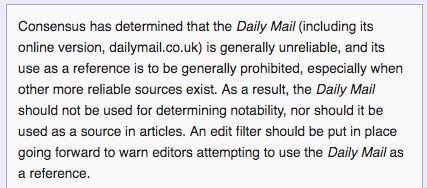
This likely is contributing to a lack of Trust (The “T” in E-A-T). However, this is not new news as this Wikipedia discussion has been present for over two years now.
We initially considered whether it was possible that Google’s algorithms got better at determining when a site had mostly tabloid, “fake news” type of information. While this is possible, we noted that other well known tabloid sites did not see drops.
One thing we did notice while perusing the majority of the major news sites is that the ad experience on the Daily Mail is horrendous. On pages we visited, we saw autoplaying video that never ended and continually played sound. Here is what we saw when trying to read content on this site…
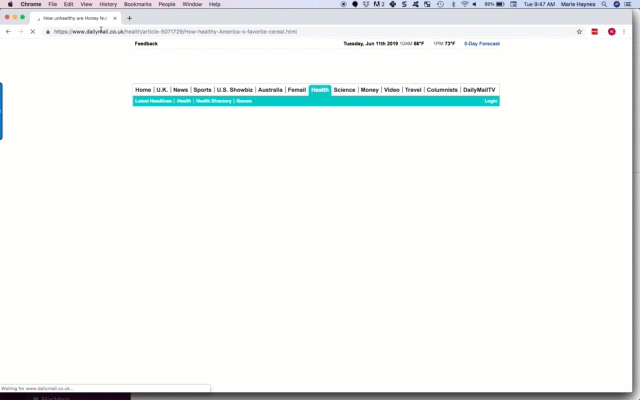
Gah! The user has notifications to block ads that are constantly flashing and obstructing the content, and more!
Keep reading for our advice on how to determine whether ads could be impacting your ability to rank.
We do believe that ad experience played a role in the Daily Mail’s drop. It is also possible that other trust issues, in addition to the ad issues added up and finally reached a level that caused Google’s algorithms to reduce their trust overall in the entire site.
What can we conclude about the June 3 core algorithm update?
It is our opinion that this core quality update was the result of Google tweaking some dials. We believe that every one of Google’s ranking factors is some type of a multiplier in their algorithms. This is likely an oversimplification, but the idea is that there are likely many factors that can be multiplied together to determine whether a site has quality issues. If one of those factors is lacking, it’s possible that it becomes a decimal multiplier...which would greatly reduce a site’s overall score.
This theory can explain why one site could be authoritative and have expertise, but if they are lacking in trust, they can fail to rank well.
With this in mind, we feel that most of the sites that saw drops had some type of issue with trust as outlined in the QRG. We have discussed trust in the QRG extensively in the past. To finish out this article, we will talk about some specific trust issues that may have been addressed by Google with the June 3 core update.
Scientific consensus
As mentioned earlier in this article, if you have posts that contradict scientific consensus, the Quality Raters are instructed to rate your article as lower quality.
For some sites, this news may mean that recovery from a core update hit could be a challenge. If the purpose of your site is to convince people that your natural remedies are better than traditional ones, recovery may be challenging.
Danny Sullivan was adamant in telling us that this update was not a Panda update.
However, he did point out that Amit Singhal’s 23 Questions on Panda are good to use as Google’s algorithm is “designed and gets improved to better reward good content.”
Several of these questions address issues that we are seeing in natural medicine sites seeing drops. They also can give us ideas on ways to improve:
- Is this article written by an expert or enthusiast who knows the topic well, or is it more shallow in nature? - For help with this, see our webinar on author E-A-T
- Does the article provide original content or information, original reporting, original research, or original analysis? - Are you just regurgitating health news people can find anywhere? Your content can succeed if you can truly put together a strong case that is original and trustworthy.
- Does the article describe both sides of a story? If you’re trying to convince the reader that a natural medicine can cure a disease, but the general scientific consensus says otherwise, you need to present both sides of the story. Explain why physicians may not agree with your treatment suggestions and then give as much good solid evidence as you can to explain your thoughts
- Is the site a recognized authority on its topic? We mentioned that Google likely turned up the dial on brand authority. Improving brand authority goes hand in hand with improving E-A-T.
- For a health related query, would you trust information from this site? Things that contribute to trust include scientific references, recommendations from experts, and more.
We believe that many natural medicine sites absolutely can see improvements, but that it will take a long time to rewrite content, get recommendations from experts and improve these sites overall to a level where Google’s algorithms will trust them.
Brand authority
We believe that Google turned up the dial in regards to how they value brand authority. What we mean by brand authority is whether or not the average person would recognize you as a leader in your field.
This can be tough to improve, but certainly can be done. The information on our E-A-T page can help here. Ultimately though, the goal is to get other experts and authoritative sites to mention you. Publish fascinating content that people truly want to link to - studies, statistics, opinion pieces, etc. Anything you can do to truly, legitimately get people saying good things about your company online can help improve your brand authority. But even better, is to find ways to get the authorities in your space to start quoting you.
What about links?
It is possible that Google has changed the way that they value keyword anchors in links. One thing that we noticed is that several of the sites that were previously ranking well for competitive terms likely had a bit of an unfair boost because of their links.
When we looked at the CCN traffic drop, we noticed that their link profile had a lot of keyword anchors. This site has a large number of keyword anchored links in their profile:
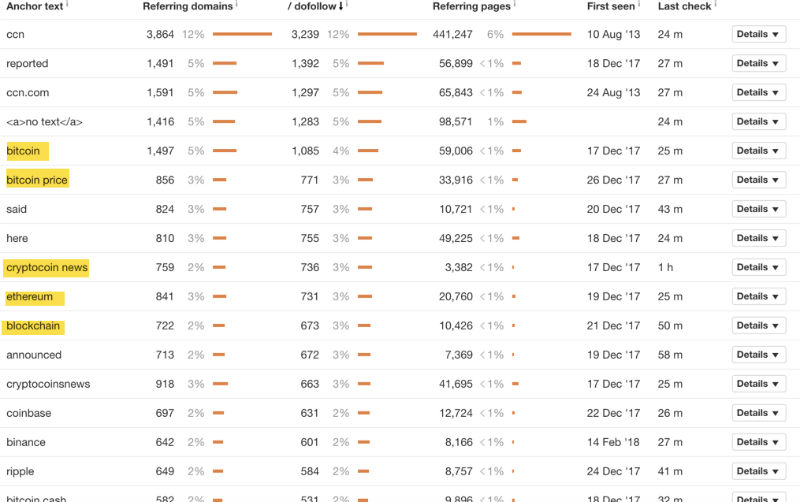
We checked out several of these links though, and they do not seem like they are there because of an SEO link scheme. Most of these are sites that legitimately want to advise their readers on what the current price of bitcoin is. The fact that they have linked with keyword anchors does not make these unnatural links. With that said, it’s certainly possible that some of these are paid, or otherwise incentivized links.
We believe that these links pushed CCN into higher than deserved rankings for a while. Sure, if a lot of people are linking to them using the keyword “bitcoin price” as an anchor, it means that people are recommending them for this topic. But, does the fact that they’ve got a lot of keyword anchored links make them a better source of information than the more widely recognized sites Coinbase and Cointelegraph? Likely no.
We have also noticed that some recipe blogging sites that were negatively affected on June 3 may have a similar issue. Many of these sites were part of blogging rings where recipe bloggers would link out to other bloggers in their group, usually with keyword anchors.
Does this mean that we should all disavow links like this? Probably not. While we do believe that there is a place for disavowing links in 2019, we do not think that sites should go about disavowing all keyword anchored links without thoroughly investigating how these links came to be.
It is possible that in many of these cases, these sites were not penalized or demoted for having these links, but rather, Google simply got better at determining which links to actually count and is now passing less PageRank through links that used to help.
Ad experience
The Quality Raters have been told for years now to assess the ad quality of pages. Many of the issues seen here are displayed on the Daily Mail’s website.
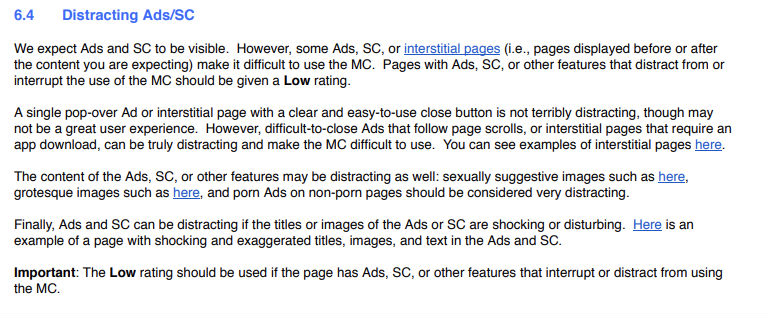
In the old version of GSC, you can access something called an “Ad Experience Report”. For years now, most sites in our profile would show no data, but quite a few now are showing this:

We have yet to see a site that has a failing grade on their ad experience report. But, if you are concerned that you may be seeing drops due to aggressive ads, and especially, use of interstitials as this was discussed as a change in the recently updated QRG, it is worth checking this report out.
With that said, even if this report does not show that Google has found problems with your ads, if you saw drops in conjunction with a core quality update and are aggressively using ads, this is an area to consider.
Are there factors to consider in this update that are not E-A-T related?
While it is certainly possible that Google has taken other factors into consideration in this update such as page speed, SSL, mobile friendliness, etc. we do thoroughly believe that every site that saw drops has issues that can be explained by our current understanding of E-A-T.
We think this update was primarily focused around Google getting better at assessing trust. This page from the QRG mentions a few things that Google considers a sign of low trust. We have highlighted the part that we feel was addressed by this update.
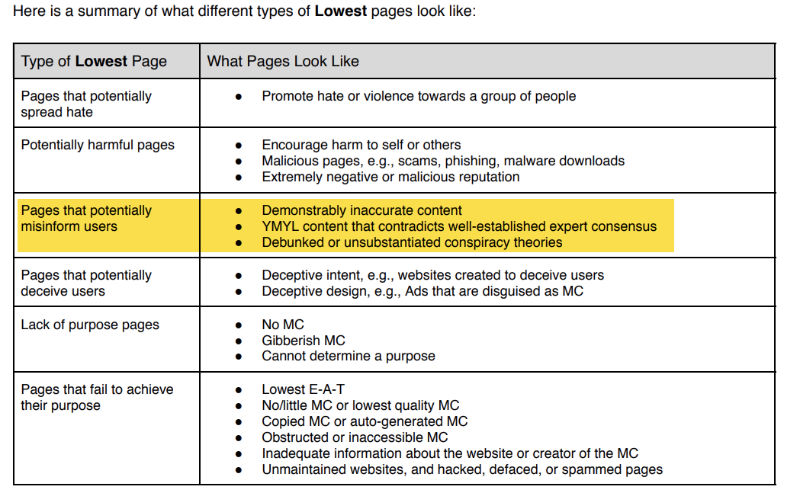
When John Mueller from Google was asked about how to recover from this update, he spoke about a particular site and mentioned several issues that could be causing Google to distrust the site. He mentioned that with quality updates there is rarely one specific thing that needs to be fixed. He then pointed people to Amit Singhal’s 23 questions as a guide to help them improve quality.
John was also asked a question about a site that was hit strongly with the March 12 core quality update. We were thrilled to see that he recommended reading our advice on E-A-T:
Need help?
While we don’t claim to have all of the answers, we have a really good track record when it comes to helping websites that have seen drops in conjunction with Google algorithm updates. Our full site review generally takes us two weeks to complete. We look at a great number of issues including technical factors, user experience and of course, we thoroughly evaluate your site in the eyes of Google’s Quality Raters’ Guidelines.
Our reports come loaded with E-A-T improvement advice that is specific to you.
You can find more information here, see some case studies, and request a proposal, on our page outlining our site quality reviews.
If our reviews are outside of your budget, we are offering a “light” version for a small handful of sites. Alternatively, we publish A LOT of information on E-A-T in our weekly newsletter and podcast.
What do you think?
Were you affected by the June 3 update? What factors do you think Google is considering? Leave a comment below.


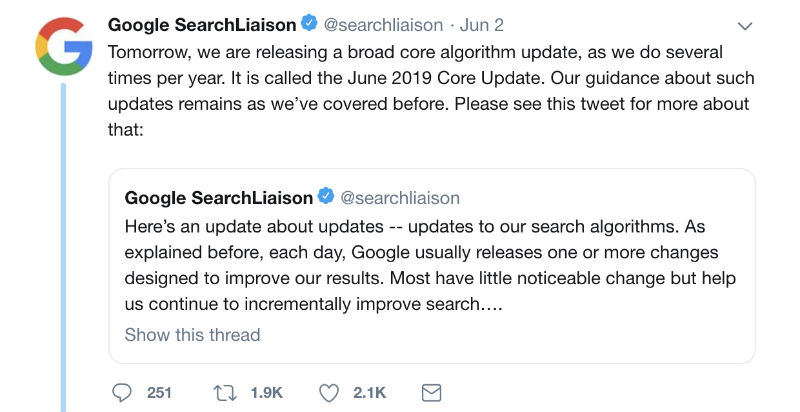
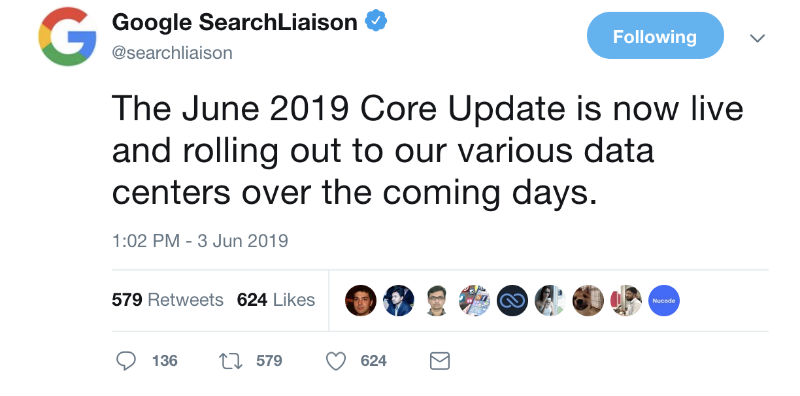
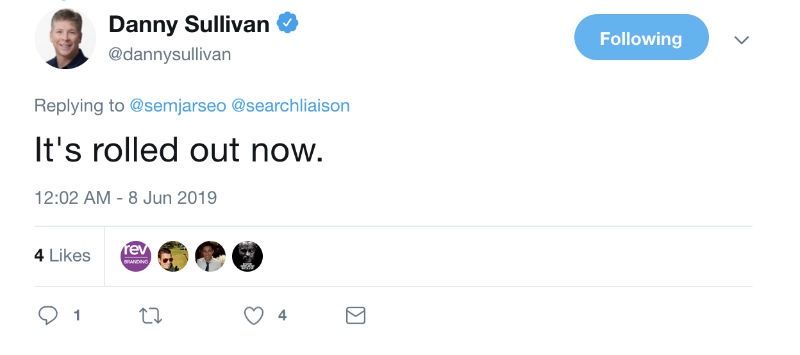
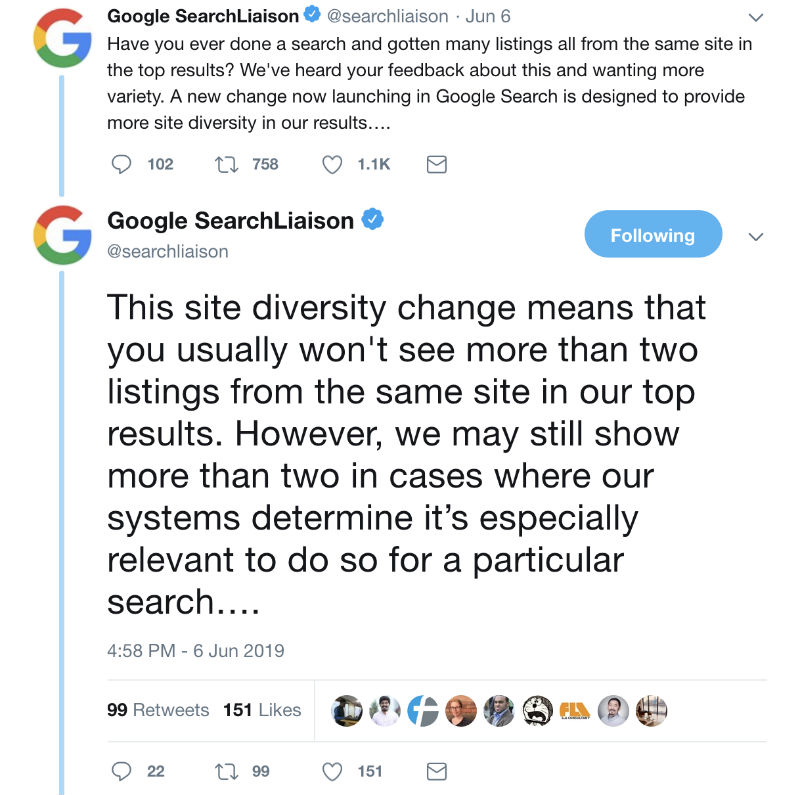
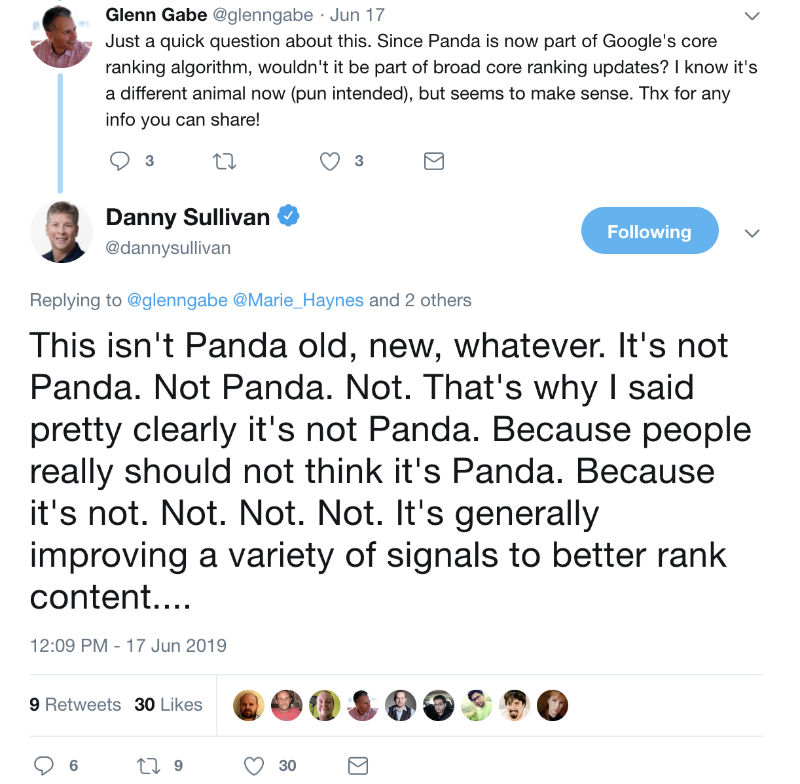
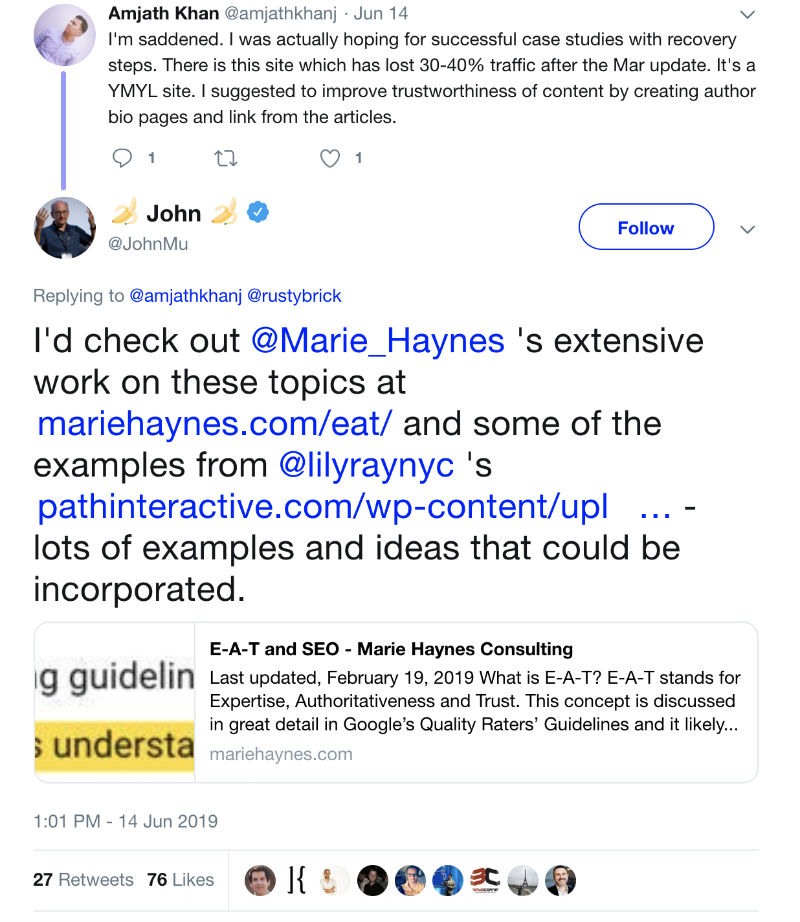

Comments
Thank you so much Marie. This was a great podcast. Very informative. I just took like two whole pages of notes from this episode. Better get to work right?! Thanks once again.
Firtstly, thank you for your great sharing about june update of Gooogle algorithm. This update slightly confusing in Indonesia since on June 5, 2019 Indonesia has an Islamic holiday called Idul Fithri. People are celebrate and did not access website normaly.
I managed several website covered any topics, including health and beauty. I saw that the traffic of health site dropped slightly.
“Each of the following sites are relatively small sites who formerly ranked for many natural medicine queries:”
I’ve noticed this too, small sites got hit. But we have not noticed the trust part about alternative facts. The biggest sites (indexed pages) we own got the highest gains, many small sites >20 pages got hit. Especially those ranking top 3.
This was very helpful.I need to check the Google quality raters guidelines again and make some more changes.These updates can be a good thing and a bad thing.The best thing is definitely maintain quality.
Yea they slammed my fireworks sites, some more than others. Not saying it’s not totally deserved but they coulda waited til August.
Ugh…sorry to hear that Netmeg….I know you’ve worked on these sites for a very long time. 🙁
Hi Marie
I have one of those health sites that was significantly affected by Google’s Core Update – overnight! My blog (which is about/for women living with heart disease) was launched 10 years ago last month, and has shown steady growth since 2009, averaging approximately 10,000 visitors/day (my max was over 20,000). But after June 3rd (and knowing nothing about Google’s Update) I happened to pop into my WordPress stats page, and almost fell off my chair!
The bar graph stats showed a staggering daily drop of about 75% compared to the day before. Stats since June 3 have hovered around 2,000 visitors/day except for a small 2-day blip up to 4,500 and 5,000 that made me hopeful – but didn’t last.
FYI, I’m not a physician, but I am a Mayo Clinic-trained patient advocate who writes evidence-based content, typically translating emerging jargon-packed studies published in cardiology journals into patient-friendly articles – which is to say that I write content that’s evidence-based. I have hundreds of blog subscribers who are cardiologists and researchers. In fact, my Heart Sisters blog has been adapted into a book published by Johns Hopkins University Press (oldest academic press in North America) who approached me out of the blue to ask if I would consider writing a book for them based on my blog articles – the first patient (ie non-physician, non-academic) author they have approached in their 140-year history). That book (“A Woman’s Guide to Living with Heart Disease”) was published 18 months ago by JHUP, was Amazon’s #1 New Release in the Medicine/Public Health category, and is already in its second printing. My blog articles have been re-published internationally, including a number of them picked up by the British Medical Journal (BMJ).
I mention these details not to brag, but only to point out that none of these facts support any concern that my content might have been de-indexed by Google because it’s considered “alternative medicine” or “low quality”.
For several years, my Heart Sisters articles have been reliably listed on Google’s first page in response to searches for info on women’s heart disease and related issues. It’s only Google searches that are down since June 3 (although Bing and other search engines have always been miles behind Google’s rank as my #1 referrer).
Since this Update hit the fan, I’ve been feeling absolutely overwhelmed. My WordPress blog host support team essentially said “We have no clue why your Google search results have drastically fallen off!”
I managed to find Google Search Console’s “investigation” page which has been depressing (for example, their first official assessment listed 345 URL’s from my site’s 800+ articles that had “images smaller than recommended” as the reason these posts were no longer being indexed by Google. Other individual URL errors picked up over the past week included pages that contained “hyperlinks too close together”.
Googles suggested remedies for each URL have had me pulling my hair out and screaming at my laptop: here’s an example of the standard error message “href error in tag a” – along with a pop up screen of html code gobbledygook….
I finally figured out that the WordPress theme I’d been using for 10 years is NOT optimized for mobile devices! This was of course a serious issue – that had never come up until this month! Ten years ago, I guess far fewer blog readers were using phones or tablets to search for my articles! I’m guessing that this could explain why too-small photos (e.g. head shots of physicians I interviewed) or hyperlinks too close together could be problematic?
So I immediately deleted my original theme and reinstalled a new mobile-friendly theme – and the Search Console’s Mobile Usability checks seem happy with my new theme – although it seems the only way to get indexed again is to submit every article URL, one by one. All 830 of them…
The bottom line: this experience has been shocking, discouraging and exhausting. I’m basically back to Square One when I was a brand new blogger with very few readers…
I’m so sorry that your rankings have dropped. It’s really hard to say exactly why as our normal site reviews take us several days to weeks to complete and find the quality issues. Things I’d look at though:
Mobile friendliness is very important.
I’d do more on your homepage and also your about page to brag about your E-A-T. More on this here:
https://www.mariehaynes.com/eat/author-eat-webinar/. Your about page is not bad, but give Google some links to follow to your books, etc. (Again, I just looked quickly, so these could actually be on the page somewhere, but it wasn’t immediately evident.)
It certainly does look like you have EAT. It may be that Google is having trouble connecting the dots. We have had cases where adding EAT related info on-page has really helped.
I’d also look at above the fold content. Every page I looked at was essentially the same, with just an image and a couple of words visible. This can cause ranking suppressions sometimes IMO.
Also, given you were hit hard with the June 3 update, I’d look to see if there is content on your site that contradicts scientific consensus. If that’s the case, you need to show both sides of the story.
Take a look at this page: https://myheartsisters.org/about-women-and-heart-disease/heart-attack-sign/. As a new reader, searching for info on whether I could be having a heart attack, I would likely turn away from this page as it looks like it has the same type of info I can find on the medical giant sites like WebMD, etc. I’d start the page off with a paragraph that explains who you are and why you are qualified to write this and also, give the user reasons to say, “Ah, I want to read THIS site rather than WebMd”
And finally, be sure to reference absolutely every scientific reference you can. There are a lot of stats on the heart attack post that are not referenced. More on this here:
https://www.mariehaynes.com/the-september-27-early-october-algorithm-update-was-likely-about-googles-ability-to-assess-trust/
Hi Marie,
Thanks for the amazing research and post. I had a few questions/ notes:
1) Did the medical sites that saw improvement had NO TRUST issue (something you highlighted as an issue with sites which saw a drop in traffic)
2)Regarding the brand update, again sites which saw improvement in your database, did all of them had a good ‘Brand’ Standing as mentioned in the QRG.
Thank you,
How do we recover from updates? Earlier there were guidelines and hints provided by community giants and Google itself. Now, it’s pretty hard to revive penalized sites.
Hi Sumit,
We’ve written a LOT of stuff on our recovery advice. I’d recommend starting here:
https://www.mariehaynes.com/eat/
Our Youtube channel has several videos on EAT along with recovery advice as well.
https://www.youtube.com/watch?v=vDUhcogUl44&list=PL_YtkLEIGy00cnlz3SBXwAMBT-CcUlzKW
In the past, when a site was negatively affected by a Google update, we could often find a smoking gun and say, “Ah, fix this and you will recover!” But now, Google is getting better at truly recognizing which sites are authoritative and trustworthy and contain the best content. When we do a site quality review, it takes us about two weeks to uncover quality issues and our advice is usually 100+ pages long as there are usually many things that could be changed.
My website where it was sitting at 1st and 2nd places for all main keywords now out of 100 and some not found. All keywords ranking dropped. Don’t know what to do now.
Hello, you can always reach out to help@mariehaynes.com if you are want to help looking into these issues.
WOW! the last 6 months have sure been busy re: G algo updates/mods 🙂
Very detailed insight coupled with stats that gives a pretty good picture of what Google may have done with this algo update.
Comments from other sources vary considerably and do not have the research data as back up – assertions like link quality was a prime target, inclusive of preference for .gov and .edu links – suggesting Google has reignited the link aspect of ranking, e.g. in line with the original PageRank, but targeting the percentage of trusted site or authority site links rather than sheer volume.
P.S. nowhere, and I mean nowhere can I find reference of authority / trust to ccTLD .gov or .edu links, e.g. like .gov.au or .edu.au, none of the big metrics sites recognize them, everything relates purely to .gov or .edu suggesting that ccTLD domains need to go beyond their ‘domain’ to get such authority links.
cheers,
Dazzlers
I don’t think I’ve ever thought that a .gov or a .edu is necessarily a better link, just because of its TLD. If you can truly get .gov or .edu sites to be recommending your content, then these are likely great links that Google would trust! But, what many people do is find ways to get a link from a subdomain of one of these sites. Those links come from a .gov or a .edu, but I believe Google is getting better at recognizing which ones are true recommendations and which ones are self made, or just there for SEO purposes.
I’m not sure that I completely understand what you are saying in the last paragraph of your comment. Can you rephrase?
I saw lots of deindexed pages with backlinks. One type is the pagination thing – you go page 3 or down further your listing is not indexed by google. The other type of backlink loss is with directories again: subcategories are deindexed in health, gambling and finance topics. I tracked several sites and I found these things in common.
Hey, Marie!
So far for me, no ranks have dropped.
I manage an ecommerce of medical equipment, I’m focusing on creating content based on E-A-T
I’m new at this, but I’ve learned a lot reading your blog.
Absolutely fantastic article – one of the best I’ve seen so far about the June update.
I can see that you refer to the DrAxe article again in your article.
I’ve noticed the many changes he’s done but they didn’t seem to convince Google.
So there is a big question here for the SEO community if we actually know how to “recover” from medic update or we are just guessing.
I suspect the Google is tending to show safe brands in the search to prevent some controversial health results. With all the privacy issues surround google and Facebook – Google just want to make sure it will not get any type of negative attention.
Personally, I think that these “medic” updates are less about showing the “best” content. There are more about showing the safest content from Google perceptive. Content that will not get negative attention from the politicians in U.S.
To me it seems that the large majority of health sites got wiped in August. There was another big wipe out on this update.
For example universityhealthnews did extremely well up to this update. But it got completely wiped out now.
Happy to get your comments Marie.
As always Marie, a fabulous detailed article – I’ve read a few other articles on the subject but they do not have anywhere near the detail, and importantly the cross section of types of sectors.
This comment was a standout to me.
“One unifying trend that we see amongst eCommerce sites that saw improvements was that they were all businesses who already had good brand recognition.”
This reinforces the need to build brand recognition. On the downside it means that the big players get a boost in SERPs that they don’t really need / deserve hence making it even harder for the ‘second tier’ or next level sites who are doing everything they can, to make meaningful gains in SERPs. We can only hope that Google can figure a way not to be putting the big guys at the top just because they are big and can afford to buy brand recognition.
Hi Marie, your article showed me the vision and the comments too give me a clear vision too.
Is there a correct way to reference research? Our site tries to reference every potentially contentious point (although we always side with the scientific consensus), but I’m not sure if the format we’re using is ideal.
The medic updates wiped out alternative health sites completely. I can find articles on Mercola or Selfhacked only if I add the “brand” name. Weird…
Excellent analysis Marie! I was struggling to understand the nature of my website’s drops and I have a few clues now after reading your article
Absolutely fantastic article – one of the best I’ve seen
very detailed article to be honest since that update in june the rankings factors had become more difficult, can you tell me what we have to focused off or on page seo?